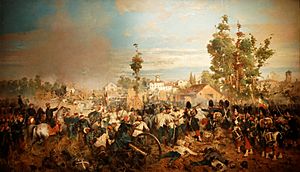Battle of Magenta facts for kids
Quick facts for kids Battle of Magenta |
|||||||
|---|---|---|---|---|---|---|---|
| Part of the Second Italian War of Independence | |||||||
 The Battle of Magenta by Gerolamo Induno. Musée de l'Armée, Paris |
|||||||
|
|||||||
| Belligerents | |||||||
| Commanders and leaders | |||||||
| Strength | |||||||
| 49,945 infantry 1,207 cavalry 87 guns |
58,183 infantry 3,435 cavalry 152 guns |
||||||
| Casualties and losses | |||||||
| 707 killed 3,223 wounded 655 missing Total: 4,585 |
1,368 killed 4,358 wounded 4,500 missing Total: 10,226 |
||||||
The Battle of Magenta was a big fight that happened on June 4, 1859. It was part of the Second Italian War of Independence. In this battle, the armies of France and Sardinia (an Italian kingdom) fought against the Austrians. The French and Sardinian forces won.
The battle took place near a town called Magenta. This area is in modern-day Italy. The French army, led by Napoleon III, crossed the Ticino River. They managed to get around the side of the Austrian army. This forced the Austrian commander, Marshal Ferencz Gyulai, to pull his troops back.
The land around Magenta was full of orchards, streams, and canals. This made it hard for large armies to move around easily. The Austrian soldiers turned many houses into small forts. A special group of French soldiers, called grenadiers of the French Imperial Guard, did most of the fighting. They still wore uniforms from an earlier time.
Even though it wasn't the biggest battle, the Battle of Magenta was a very important win for France and Sardinia. A French general named Patrice de MacMahon played a key role. Because of his actions, he was given the title of Duc de Magenta. He later became the President of France. Most of the soldiers fighting for France and Sardinia were French. Only about 1,100 were from Sardinia, while 58,000 were French.
Contents
Why the Battle Happened
From June 1 to June 3, the French and Sardinian armies chased the Austrian army. They followed them to the Ticino River. This river was the border between two regions, Lombardy and Piedmont.
The Austrians set up their defenses at Magenta. They used a large canal called the Naviglio Grande. There were only four bridges to cross this canal. The Austrian commander, Gyulai, had about 68,000 soldiers ready. The French had about 50,000 soldiers. Another 12,000 Sardinian soldiers joined them.
Two French generals, Camou and MacMahon, had already crossed the Ticino River. They crossed during an earlier fight called the Battle of Turbigo. MacMahon, Camou, and Espinasse then crossed the canal using bridges. This put them north of Magenta, ready for the main battle.
What Happened During the Battle
The fighting began around noon. General MacMahon's troops met some of the Austrian soldiers. At the same time, the French Imperial Guard Corps started fighting the Austrians. This happened between two towns, Buffalora and Magenta.
Around 2 PM, a special group of French soldiers called Guard Zouaves crossed the canal using boats. They set up a small area on the other side, called a bridgehead. This meant more French troops could cross.
An Austrian general, Eduard Clam-Gallas, told Gyulai about the French attack. Gyulai sent more Austrian troops to attack the French from their right side. But another French general, Canrobert, arrived just in time to help the Imperial Guard.
From 3:30 PM to 5:30 PM, MacMahon led a strong attack against the Austrian forces. By 6:30 PM, the Austrians started to pull back, fighting as they went. The French army moved forward into Magenta and beyond. By 10 PM, the Austrian army was fully retreating. They moved towards a town called Abbiategrasso.
What Happened After the Battle
After their victory, Napoleon III and Victor Emmanuel II entered the city of Milan on June 8. A few days later, they also entered Brescia.
Another French army group landed in Livorno in May. They then entered Florence a week later. After that, they moved into Parma and Modena.
The defeat at Magenta was a big blow for the Austrian commander, Gyulai. He moved his army back to the Chiese River and resigned from his position on June 16.
An interesting fact: a new color dye was invented in 1859. It was named magenta after this battle. Also, a street in Paris, the Boulevard de Magenta, is named after this important event.
Images for kids
See also
 In Spanish: Batalla de Magenta para niños
In Spanish: Batalla de Magenta para niños



